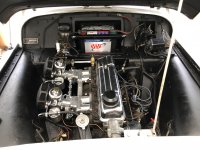I have just rebuilt the carbs for the TR3B I am brining back to life.
I got the carb kit from TRF and followed the directions on the cork jet seals soaking them in oil. Left them over night in a dish of oil.
Polished the choke jets and reassembled the carbs. The choke jets move nicely and the jets are centered. The jet centering nuts are tight.
Fired the TR3B up and ran it for a few minutes. This highlighted a hole in the exhaust pipe just below the manifold. Then I noticed that both carbs are leaking at the bottom of the jets.
Did I mess up the cork seals? Are the "O" ring seals better and would Hardware "O" rings work?
David
I got the carb kit from TRF and followed the directions on the cork jet seals soaking them in oil. Left them over night in a dish of oil.
Polished the choke jets and reassembled the carbs. The choke jets move nicely and the jets are centered. The jet centering nuts are tight.
Fired the TR3B up and ran it for a few minutes. This highlighted a hole in the exhaust pipe just below the manifold. Then I noticed that both carbs are leaking at the bottom of the jets.
Did I mess up the cork seals? Are the "O" ring seals better and would Hardware "O" rings work?
David

 Hi Guest!
Hi Guest!

 smilie in place of the real @
smilie in place of the real @
 Pretty Please - add it to our Events forum(s) and add to the calendar! >>
Pretty Please - add it to our Events forum(s) and add to the calendar! >> 



